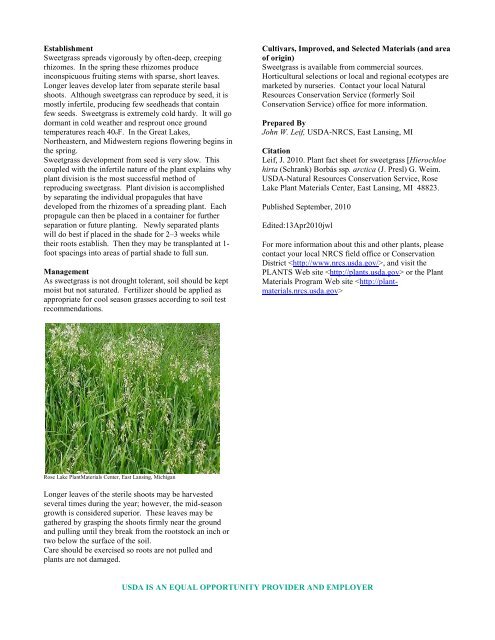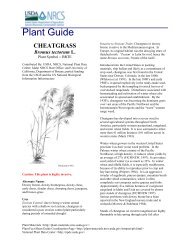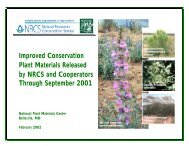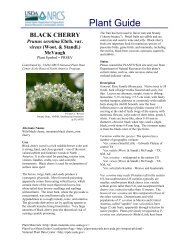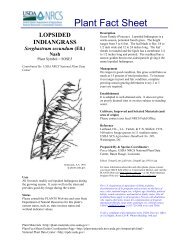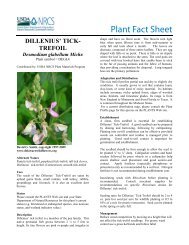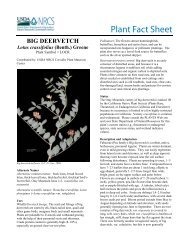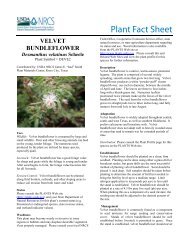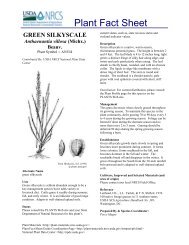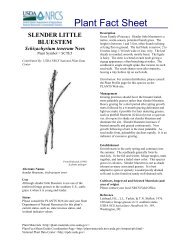Northern Sweetgrass (Hierochloe hirta) - USDA Plants Database
Northern Sweetgrass (Hierochloe hirta) - USDA Plants Database
Northern Sweetgrass (Hierochloe hirta) - USDA Plants Database
Create successful ePaper yourself
Turn your PDF publications into a flip-book with our unique Google optimized e-Paper software.
Establishment<br />
<strong>Sweetgrass</strong> spreads vigorously by often-deep, creeping<br />
rhizomes. In the spring these rhizomes produce<br />
inconspicuous fruiting stems with sparse, short leaves.<br />
Longer leaves develop later from separate sterile basal<br />
shoots. Although sweetgrass can reproduce by seed, it is<br />
mostly infertile, producing few seedheads that contain<br />
few seeds. <strong>Sweetgrass</strong> is extremely cold hardy. It will go<br />
dormant in cold weather and resprout once ground<br />
temperatures reach 40oF. In the Great Lakes,<br />
Northeastern, and Midwestern regions flowering begins in<br />
the spring.<br />
<strong>Sweetgrass</strong> development from seed is very slow. This<br />
coupled with the infertile nature of the plant explains why<br />
plant division is the most successful method of<br />
reproducing sweetgrass. Plant division is accomplished<br />
by separating the individual propagules that have<br />
developed from the rhizomes of a spreading plant. Each<br />
propagule can then be placed in a container for further<br />
separation or future planting. Newly separated plants<br />
will do best if placed in the shade for 2–3 weeks while<br />
their roots establish. Then they may be transplanted at 1foot<br />
spacings into areas of partial shade to full sun.<br />
Management<br />
As sweetgrass is not drought tolerant, soil should be kept<br />
moist but not saturated. Fertilizer should be applied as<br />
appropriate for cool season grasses according to soil test<br />
recommendations.<br />
Rose Lake PlantMaterials Center, East Lansing, Michigan<br />
Longer leaves of the sterile shoots may be harvested<br />
several times during the year; however, the mid-season<br />
growth is considered superior. These leaves may be<br />
gathered by grasping the shoots firmly near the ground<br />
and pulling until they break from the rootstock an inch or<br />
two below the surface of the soil.<br />
Care should be exercised so roots are not pulled and<br />
plants are not damaged.<br />
Cultivars, Improved, and Selected Materials (and area<br />
of origin)<br />
<strong>Sweetgrass</strong> is available from commercial sources.<br />
Horticultural selections or local and regional ecotypes are<br />
marketed by nurseries. Contact your local Natural<br />
Resources Conservation Service (formerly Soil<br />
Conservation Service) office for more information.<br />
Prepared By<br />
John W. Leif, <strong>USDA</strong>-NRCS, East Lansing, MI<br />
Citation<br />
Leif, J. 2010. Plant fact sheet for sweetgrass [<strong>Hierochloe</strong><br />
<strong>hirta</strong> (Schrank) Borbás ssp. arctica (J. Presl) G. Weim.<br />
<strong>USDA</strong>-Natural Resources Conservation Service, Rose<br />
Lake Plant Materials Center, East Lansing, MI 48823.<br />
Published September, 2010<br />
Edited:13Apr2010jwl<br />
For more information about this and other plants, please<br />
contact your local NRCS field office or Conservation<br />
District , and visit the<br />
PLANTS Web site or the Plant<br />
Materials Program Web site <br />
<strong>USDA</strong> IS AN EQUAL OPPORTUNITY PROVIDER AND EMPLOYER


